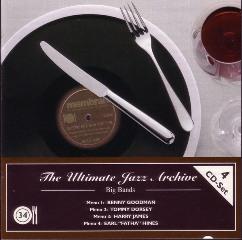The Ultimate Jazz Archive Vol.134 – Tommy Dorsey [1935-1938] [2005]
The Ultimate Jazz Archive Vol.134 – Tommy Dorsey [1935-1938] [2005]

01.Weary Blues 02.Royal Garden Blues 03.Tea On The Terrace 04.I’m In A Dancing Mood 05.Keepin’ Out Of Mischief Now 06.Jamboree 07.Mr. Ghost Goes To Town 08.Lookin’ Around Corners For You 09.Who’ll Buy My Violets 10.On A Little Bamboo Bridge 11.Melody In F 12.Song Of India 13.Marie 14.In A Little Hula Heaven 15.I’ll Dream My Way To Heaven 16.Liebestraum 17.Mendelssohn’s Spring Song 18.The Sheik Of Araby 19.Boogie Woogie 20.Hawaiian War Chant
(1905 - 1956) Trombonist and dance-band leader Brother of Jimmy Dorsey
Tommy Dorsey studied trumpet with his father, a part-time musician, and later changed to trombone. With his brother Jimmy he was leader of Dorsey's Novelty Six and Dorsey's Wild Canaries, then in the early 1920s played with the Scranton Sirens. Later in the decade Tommy worked with such prominent dance orchestras as those led by Jean Goldkette and Paul Whiteman. He then moved to New York, where he was in demand as a player in studio and pit orchestras. In 1934 he founded with Jimmy the successful but short-lived Dorsey Brothers Orchestra. After a public argument in 1935 the two separated, and Tommy organized a dance orchestra of his own, which quickly became one of the most popular of the swing era.
The band's music was characterized by smooth, well-crafted arrangements played with great precision and, at times, with excellent jazz solos by Bunny Berigan, Yank Lawson, Buddy Rich, and others. One of its most successful recordings was Boogie Woogie (1938), an orchestral adaptation of a piano piece by Pine Top Smith; other hits included lively swing versions of Marie and Song of India (1937), both with brilliant solos by Berigan. However, Dorsey's orchestra was known primarily for its renderings of ballads at dance tempos, frequently with singers such as Jack Leonard and Frank Sinatra.
After the collapse of the swing-band movement in the late 1940s Dorsey struggled to keep his band intact. Eventually he brought in his brother Jimmy and the two ran another version of the Dorsey Brothers Orchestra (1953-6) which had some success, particularly in its television appearances.
Although Dorsey recorded, especially in the 1920s, with Bix Beiderbecke and other major jazz players, he was not a notable jazz soloist. He was vastly admired by other musicians, however, for his technical skill on his instrument. His tone was pure, his phrasing was elegant, and he was able to play an almost seamless legato line; as a player of ballads he has rarely been surpassed. --- pbs.org
download: uploaded anonfiles yandex 4shared solidfiles mediafire mega filecloudio








